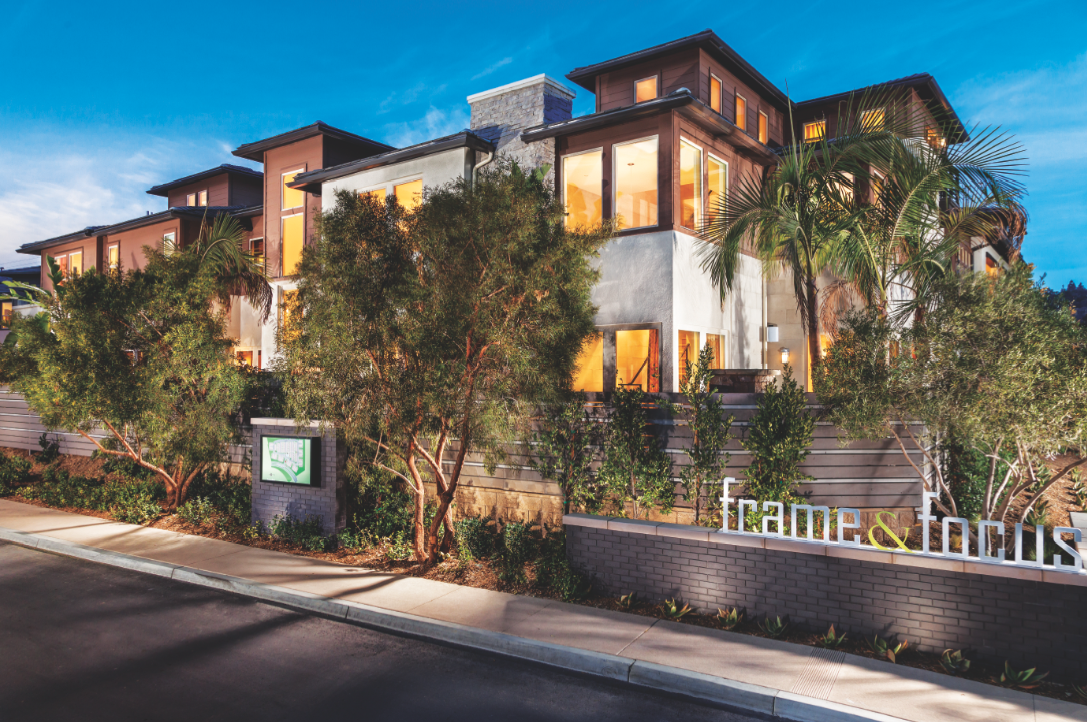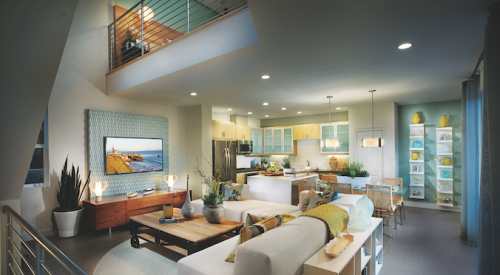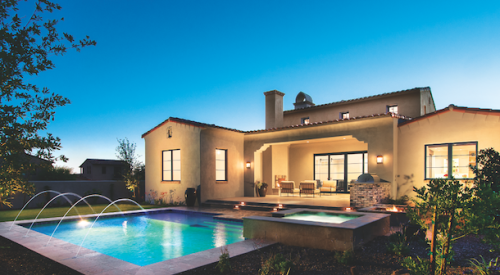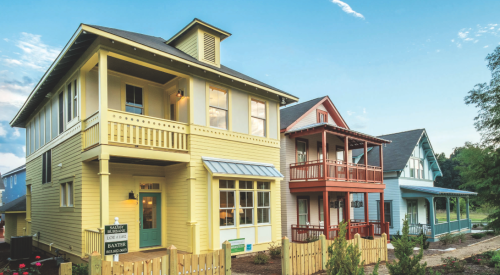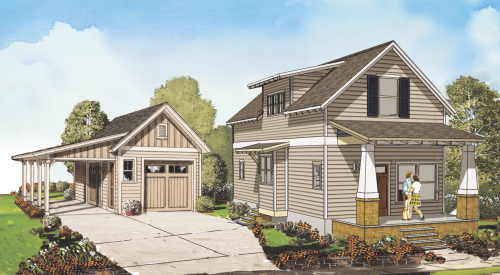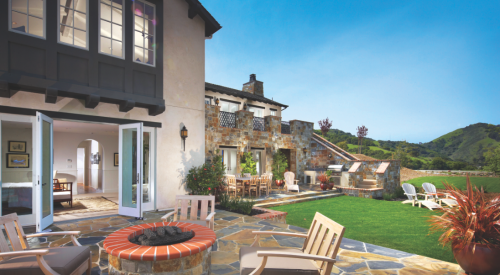Once a site is acquired, the hard work of designing the community begins. As much art as science, good community design seeks to craft the most successful and profitable use of the available space while meeting its infrastructure requirements. The art comes from creating an environment that speaks to the target buyers. In a well-designed neighborhood, buyers can’t quite put their finger on it, but something about the place just feels right to them. We looked at four communities that have taken design to award-winning levels and paid off in strong sales and satisfied homebuyers.
Frame and Focus
The bar was set high for Frame and Focus, a neighborhood of motor court homes and two-story row homes within the Civita master planned community in San Diego. The neighborhood is being built by Shea Homes, the first builder doing for-sale housing in Civita, a $2 billion, 230-acre urban village built on a former sand and gravel quarry. Shea Homes’ first community in Civita, Origen, was a 200-unit townhome project with two options, skyLoft and socialGarden. The builder’s first foray into vertical architecture and urban infill, Origen won five gold awards at The Nationals in 2013, including Neighborhood of the Year. Both communities were designed by Woodley Architectural Group.
“We designed this new community for a different demographic than what we had at our skyLoft and socialGarden,” says Vanessa Linn, vice president of sales and marketing for Shea Homes San Diego. “Both of those neighborhoods attracted move-up buyers who were slightly older and had children who were living at home on the weekends or for shorter periods of time. We wanted our new neighborhoods to not compete with each other and designed for the first-time buyer and some move-up with children.”

The unusual name of the community, Frame and Focus, speaks to the way the neighborhood was laid out to adapt to the site. The Frame product wraps around the perimeter of the neighborhood, literally providing a frame. That arrangement provided room for motor court homes with two-car garages, patios, and private rear spaces for young children, small pets, or private dining. Shea adapted the motor court concept from an earlier project, Mandolin at Del Sur, where they had seen it help develop a strong sense of community.
“On the weekends, all the garage doors are open with children playing and running in and out of each other’s homes,” Linn says. “We designed Frame to have the same type of motor court. We knew we’d have kids playing in the courtyards, which is also the access to all the front doors. We needed to dress it up a bit because people will be hanging out there. We made sure we paid attention to that. We added stone and flatwork, with a tree in the center of the courtyard. Most neighborhoods don’t go to that extent with the flatwork—-it’s quite beautiful.”
The Focus portion of the neighborhood, built to appeal to first-time buyers, occupies the interior of the site; the private space for those buyers is a “little front yard with a gate,” Linn says.
Since Civita is still in its first phase, amenities are not yet in place, and buyers want to know that the amenities are coming, Linn said. One of the central site elements for Civita is a 20-acre park and civic area; buyers today can participate in approving plans for the park’s features. “That’s a nice thing no other community can say,” Linn says.
Kensett at Darien
It’s tough to find sufficient acreage in the densely populated Northeast to build a neighborhood; sometimes you have to take what’s available and make it work. Sun Homes partners Bob Dale and Bill McGuinness found a diamond in the rough with Kensett, a 16-acre site in Darien, Conn., a highly desirable address for New York commuters, where no large housing development had been built in a generation. Kensett won gold awards at The Nationals for clubhouse design and attached home plan, and silver for Neighborhood of the Year and landscape design.
The site will accommodate 62 attached condominiums ranging from 3,200 to 4,400 square feet; prices start at $1.3 million. Community features include a New England-style meeting house with a hip lobby bar, a heated lap pool, and accommodations for overnight guests.
McGuinness says he drew on his upbringing in land-constrained Vancouver to overcome “some pretty serious adjacency issues—we’re alongside railroad tracks, two cemeteries, and a bunch of not as nice houses”—and still attract luxury buyers to a dense, infill neighborhood.
“We deal with (the adjacency issues) using all sorts of measures,” McGuinness says. “We spend an incredible amount of money on landscaping. To us, it’s the cost of adding to the value of the home and the site. And it’s next to a five-acre preserve; there are walking trails, a bit of a shallow valley, and verdant hills that are very, very nice.”
Initially, the design-build team at Sun Homes thought its target buyer would be empty nesters looking for high-end, maintenance-free living—and those buyers certainly have responded to the neighborhood. But McGuinness says he’s been pleasantly surprised that it also has appealed to a wider demographic, including single buyers, divorced parents, and even a multigenerational family ranging in age from the 40s to the 90s.
“The younger people recognize this as a more fun, amenitized lifestyle,” he says. “They don’t want the effort and expense of taking care of a big lot. These are condos—they have no responsibility from the midpoint of the wall on out. It’s as close to a resort lifestyle as you can get in the Northeast.”
The Sun Homes team has listened carefully to its buyers to learn what’s most important to them in site design. “They want to feel they have their own private outdoor space and that their home is their home—they don’t want to feel too communal,” McGuinness says. “When they step on their patio, they want to feel like it’s their garden from there to the property line or the fence. When it comes to the community itself, there are public places and private places and it’s clear which is which. That really matters to people.”
The primary public place at Kensett is its clubhouse, which was designed as a civic building and built to resemble an old Federal-style church that had been repurposed as a boutique hotel lobby with a bar.
“The empty-nester clubhouse is usually a very sedentary place with card rooms and couches where people sit around,” McGuinness says. “We didn’t want that. We did a big bar with a grand piano, a big table that breaks down for a dance floor, and a really big fireplace. We’re saying, ‘You’re not going to come here and listen to the clock ticking. You can throw a real bash here.’”
Hammond’s Ferry
Dubbed South Carolina’s riverfront, Hammond’s Ferry in North Augusta, S.C., is a TND development that takes full advantage of its location on the banks of the Savannah River. Yet its site plan takes a very different approach from many master planned communities in that it fully integrates with the surrounding city. There are no gates or guard booths. In fact, the city-maintained Greeneway, a 7-mile rails-to-trail walking and biking trail that connects many of the city’s neighborhoods to public parks and downtown, runs between one of Hammond’s Ferry’s parks and the river. It’s common to see events that are open to the public, including morning yoga classes and free concerts.
Following classic TND design principles, streets in Hammond’s Ferry are narrow and curving to slow down traffic. Houses are pulled forward on the lots and nearly all the houses have front porches to promote interaction and a sense of community. All of the garages are alley loaded.
Development in the 200-plus acre neighborhood is centered around two small commercial areas with retail, restaurants, and offices; the on-site Blue Clay Farm supplies some of the organic, regional fare on the menu at Manuel’s Bread Café, an upscale country French restaurant where residents often gather for dinner, Sunday brunch, or a glass of wine.
Protected green space includes Brick Pond Park, the first urban ecology park in the Southeast. The park restored a drainage basin, creating a protected habitat with paths, boardwalks, and outdoor classrooms to observe resident birds, deer, turtles, and alligators. A 150-acre park with soccer fields, playgrounds, tennis courts, an 18-hole disc golf course, and an expansive activities center are a short bike ride away.
Another uncommon feature of the site plan, town architect Richard Fletcher says, is in the placement of various housing types. The site is designed for 800 to 1,000 residential units ranging from the high $200,000s to $1 million-plus. Build-out began in 2006. Where it’s typical for communities to carve out separate neighborhoods by product and price point, Hammond’s Ferry commonly has small cottages, condos, apartments, live/work spaces, townhomes, and estate homes within steps of each other.
“That’s how neighborhoods are,” Fletcher says. “You have one housing type next to another.”
Certain lots have architectural requirements that respond to the site plan. Houses that front the river, for example, are required to have two-story porches; other lots are designated for two-story houses. The height from the homes along those streets creates an outdoor vertical space, Fletcher says, that is intrinsically comfortable and welcoming and works well for capturing the nearby river breezes.
Homebuyers can select from among the community’s Builders’ Guild, a small group of high-quality local builders who know and embrace the neighborhood’s strict design guidelines, as well as energy-efficient building practices.
Planned phases of Hammond’s Ferry are designed to connect it even more closely to the city; the site plan includes streets that tie directly to North Augusta’s nearby downtown. Also in the works on adjacent riverfront property is a proposed minor league baseball stadium with retail space, a hotel and conference center, and a major office complex for a health care company.
Walden
Charter Homes of Lancaster, Pa., is an old hand at designing award-winning communities. Its Walden development in Mechanicsburg, Pa., earned a 2013 Best in American Living Award and was named one of the best neighborhoods in the country. The community, the first new village built on Harrisburg’s West Shore in more than 100 years, features an abundance of open space and gathering places, including fit pits, walking trails, and a three-acre TerraPark, the area’s first all-natural playground.
“People have looked at the TerraPark and asked when it will be developed,” says Lauren Spamer, vice president of sales and marketing at Charter Homes. “We tell them never.”
The builder is now taking everything it learned in developing Walden to Highpoint Arcona, “the village on a hill,” a new neighborhood of single-family homes and townhomes that encompasses rural, village, and urban living in one master planned community. Single-family floorplans range from 1,900 to 3,400 square feet, starting in the $260,000s; the entry is flanked with townhomes and commercial space topped with live/work units.
One of the site plan goals for both communities was to create spaces where people can connect, including walking trails, sidewalks, and places to walk their dogs. “Pools and clubhouses are not big anymore,” Spamer says. “People want outdoor exercise and business amenities. They want to be able to walk to a coffee shop. We have a pilates studio at The Shops at Walden.”
Charter tries to be “very thoughtful” about the way it lays out streets. Like Hammond’s Ferry in South Carolina, both Walden and High Point feature narrow, curving streets that encourage slow driving. Street trees are situated next to the roads so they don’t hide the homes, and to create an inviting natural canopy.
Another common tool in the Charter Homes’ site design kit is to try to lay out six homes at a time and face them toward an amenity or have them hug a curve in the road. The goal is to create multiple focal points throughout the community.
The new neighborhood features more than 10 acres of open, preserved spaces and is walking distance to village-style shopping in the adjacent Arcona Crossroads. “We get a lot of people who are very busy,” Spamer says. “The half-acre to one acre sites of the past have gone the way of the dinosaur. People want their own space, but they want open spaces too—a couple acres for the kids to play without having to spend their weekends taking care of it. We call it the 15-minute vacation.” PB















